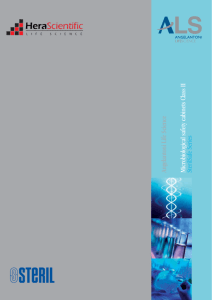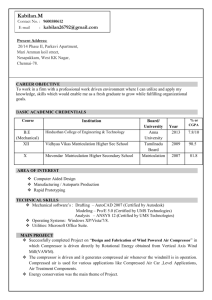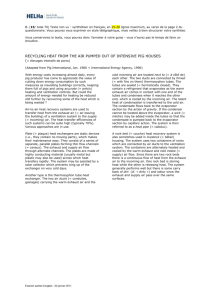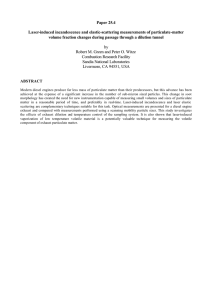MYCOBACTERIAL LABORATORIES -BSL3 LABS ARCHITECTURAL AND ENGINEERING CONTROLS UPDATE
advertisement
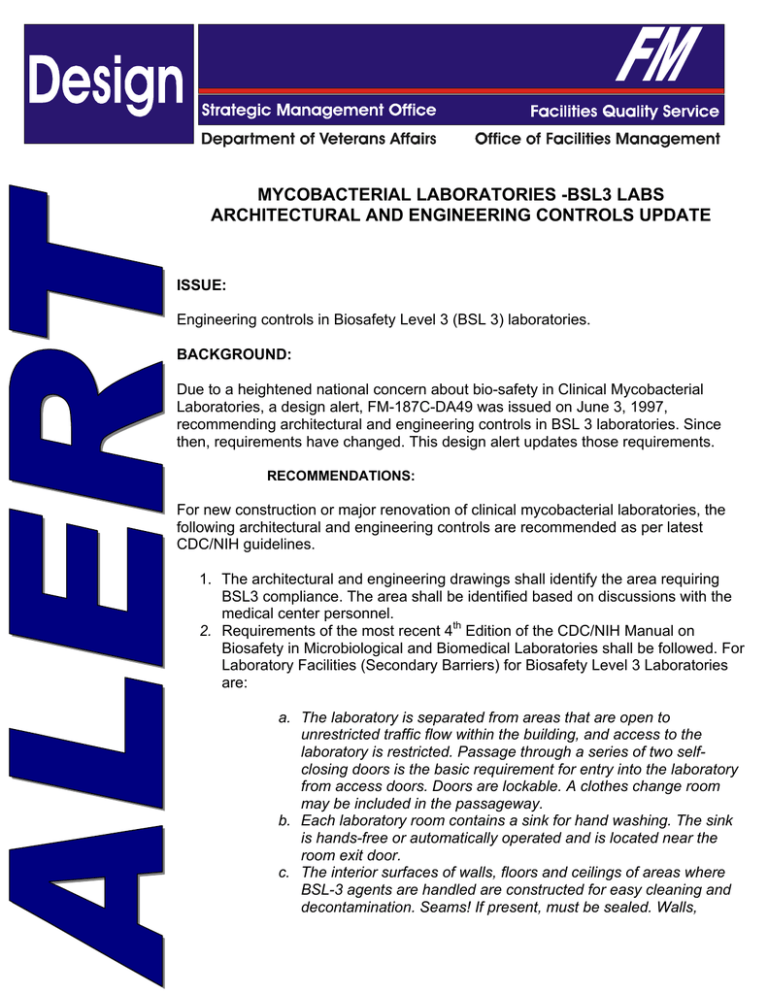
MYCOBACTERIAL LABORATORIES -BSL3 LABS ARCHITECTURAL AND ENGINEERING CONTROLS UPDATE ISSUE: Engineering controls in Biosafety Level 3 (BSL 3) laboratories. BACKGROUND: Due to a heightened national concern about bio-safety in Clinical Mycobacterial Laboratories, a design alert, FM-187C-DA49 was issued on June 3, 1997, recommending architectural and engineering controls in BSL 3 laboratories. Since then, requirements have changed. This design alert updates those requirements. RECOMMENDATIONS: For new construction or major renovation of clinical mycobacterial laboratories, the following architectural and engineering controls are recommended as per latest CDC/NIH guidelines. 1. The architectural and engineering drawings shall identify the area requiring BSL3 compliance. The area shall be identified based on discussions with the medical center personnel. 2. Requirements of the most recent 4th Edition of the CDC/NIH Manual on Biosafety in Microbiological and Biomedical Laboratories shall be followed. For Laboratory Facilities (Secondary Barriers) for Biosafety Level 3 Laboratories are: a. The laboratory is separated from areas that are open to unrestricted traffic flow within the building, and access to the laboratory is restricted. Passage through a series of two selfclosing doors is the basic requirement for entry into the laboratory from access doors. Doors are lockable. A clothes change room may be included in the passageway. b. Each laboratory room contains a sink for hand washing. The sink is hands-free or automatically operated and is located near the room exit door. c. The interior surfaces of walls, floors and ceilings of areas where BSL-3 agents are handled are constructed for easy cleaning and decontamination. Seams! If present, must be sealed. Walls, d. e. f. g. h. i. j. k. l. m. n. ceilings, and floors should be smooth, impermeable to liquids and resistant to the chemicals and disinfectants normally used in the laboratory. Floors should be monolithic and slip-resistant. Consideration should be given to the use of coved floor coverings. Penetrations in floors, walls, and ceiling surfaces are sealed. Openings such as around ducts and the spaces between doors and frames are capable of being sealed to facilitate decontamination. Bench tops are impervious to water and are resistant to moderate heat and the organic solvents, acids, alkalis, arid those chemicals used to decontaminate the work surfaces and equipment. Laboratory furniture is capable of supporting anticipated loading and uses. Spaces between benches, cabinets, and equipment are accessible for cleaning. Chairs and other furniture used in laboratory work should be covered with a non-fabric material that can be easily decontaminated. All windows in the laboratory are closed and sealed. A method for decontamination all laboratory wastes is available in the facility and utilized, preferably within the laboratory (i.e., autoclave chemical disinfections, incineration, or other approved decontamination method). Consideration should be given to means of decontaminating equipment. If waste is transported out of the laboratory, it should be properly sealed and not transported in public corridors. Biological safety cabinets are required and are located away from doors, from room supply louvers, and from heavily traveled laboratory areas. A ducted exhaust air ventilation system is provided. This system creates directional airflow, which draws air into the laboratory from “clean” areas and toward “contaminated” areas. The exhaust air is not re-circulated to any other area of the building. Filtration and other treatments of the exhaust air are not required, but may be considered based on site requirements, and specific agent manipulations and use conditions. The outside exhaust must be dispersed away from occupied areas and air intakes, or the exhaust must be HEPA-filtered. Laboratory personnel must verify that the direction of the air flow (into the laboratory) is proper. It is recommended that a visual monitoring device that indicates and confirms directional inward airflow be provided at the laboratory entry. Consideration should be given to installing an HVAC control system to prevent sustained positive pressurization of the laboratory. Audible alarms should be considered to notify personnel of HVAC system failure. HEPA-filtered exhaust air from Class II biological safety cabinet can be re-circulated into the laboratory, if the cabinet is tested and certified at least annually. When exhaust air from Class II safety cabinet is to be discharged to the outside through the building exhaust air system, the cabinet must be connected in a manner that avoids any interference with the air balance of the cabinets or the building exhaust system (i.e. an air gap between the cabinet exhaust and the exhaust duct). When Class III biological safety cabinets are used, they should be directly connected to the exhaust system. If the Class III cabinets are connected to the supply system, it is done in a manner that prevents positive pressurization of the cabinets. Continuous flow centrifuges or other equipment that may produce aerosols are contained in devices that exhaust air through HEPA filters before discharge into the laboratory. These HEPA systems are tested at least annually. Alternatively, the exhaust from such equipment may be vented to the outside if it is dispersed away from occupied areas and air intakes. Vacuum lines are protected with liquid disinfectant traps and HEPA filters, or their equivalent. Filters must be replaced as needed. An alternative is to use portable vacuum pumps (also properly protected with traps and filters). An eyewash station is readily available inside the laboratory. Illumination is adequate for all activities, avoiding reflections and glare that could impede vision. o. The Biosafety Level 3 facility design and operational procedures must be documented. The facility must be tested for verification that the design and operational parameters have been met prior to operation. Facilities should be re-verified, at least annually, against these procedures as modified by operational experience. p. Additional environmental protection (e.g. personnel showers, HEPA filtration of exhaust air, containment of other piped services and the provision of effluent decontamination) should be considered, if recommended by the agent summary statement, as determined by risk assessment, the site conditions, or other applicable federal, state, or local regulations. 1. Minimum air changes per hour for laboratory shall be 12. 2. Biological Safety Cabinet hood exhaust shall be on emergency power. 3. Although CDC/NIH in paragraph 2.j above allows re-circulation of air from Class II cabinets or use of building exhaust system, VA criteria requires an independent dedicated exhaust system for each Class II and Class III hood. 4. Hood exhaust ducts shall not be housed in the same shaft carrying environmental supply, return or other non-hazardous exhaust ducts from the building. 5. Run Biological safety cabinet exhaust fans continuously. 6. Access FM Technical Information Library (TIL) at http://www.va.gov/facmgt/standard for design manuals and master specifications. Previous Design Alert FM-187C-DA 49 dated June 3, 1997 is rescinded. FOR ADDITIONAL INFORMATION: Contact Satish Sehgal at 202-565-5032, Facilities Quality Service (181A). 15 September 2004 FM-181A-DA-121
